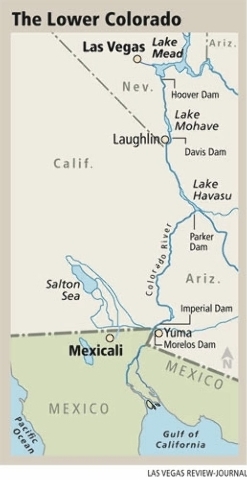Colorado River water pact could be model for other nations
A new Colorado River agreement between the United States and Mexico could serve as a model for other countries locked in conflict over water.
That was the message Thursday as the sweeping, five-year pact was approved by the Southern Nevada Water Authority and the Colorado River Commission of Nevada in a rare joint meeting.
The landmark deal won't become official until representatives for the United States and Mexico sign it on Tuesday, but water authority chief Pat Mulroy said she already has talked to several people from Africa, Asia and Australia who want to read and perhaps borrow from the water accord.
"This agreement will go down as a blueprint across the globe," she said.
Boulder City Councilman Duncan McCoy, who serves on the boards of both the water authority and the river commission, called it "a beautiful example of what can happen when friends sit down to solve a common problem."
The agreement could boost Lake Mead by allowing Mexico to store some of its annual Colorado River allotment in the reservoir for future use.
It also clears the way for the U.S. government and several municipal water agencies, including the authority, to invest in infrastructure improvements in Mexico in return for a share of the water such projects would save.
And it includes environmental provisions for restoring the flow of the Colorado River to the Gulf of California on a small, experimental scale.
The Southern Nevada Water Authority and the Colorado River Commission manage the state's share of water and power from the river. In separate votes at the same meeting Thursday, the boards of the two agencies approved five different interlocking agreements, including an amendment, known officially as Minute 319, to the 1944 treaty between the United States and Mexico.
Kip White, spokesman for the U.S. Bureau of Reclamation, said the documents will be signed by officials from the two countries during a ceremony Tuesday in San Diego.
The event is still being arranged, but Interior Secretary Ken Salazar and Reclamation Commissioner Michael Connor might attend with representatives from the Mexican government, the International Boundary and Water Commission and the seven U.S. states that share the Colorado River.
Under the pact, Mexico could leave as much as 1.5 million acre-feet of water in Lake Mead over five years.
That is enough water to raise the lake's surface by as much as 15 feet and offer some much needed protection for the intake pipes through which the Las Vegas Valley draws 90 percent of its drinking water.
Nevada also stands to gain some water through the international agreement.
In exchange for a $2.5 million investment in infrastructure south of the border, the water authority would get a one-time share of 23,700 acre-feet from the savings Mexico expects to see by lining irrigation canals and upgrading the way crops are irrigated.
One acre-foot is enough water to supply two average Las Vegas homes for one year.
The $2.5 million would be paid to Mexico over three years starting in 2014. The authority would have until 2036 to draw on the 23,700 acre-feet it would get for its money.
The two largest municipal water agencies in Arizona and California - the Central Arizona Water Conservation District and the Metropolitan Water District of Southern California - have reached similar deals to help fund efficiency improvements in Mexico and share in the water savings.
Las Vegas City Councilman Bob Coffin, also a member of both the authority and commission boards, noted how unusual it is for individual states to enter into treaties with foreign countries.
"It just doesn't happen," he said.
"Just the notion that one country would use its facilities to store water for another country is a huge issue," Mulroy said.
Colorado River Commission Chairman George Ogilvie said the agreement is "truly the culmination of a tremendous amount of effort."
The negotiations went on for years and occasionally involved meetings of 40 to 50 people that ended fruitlessly, Ogilvie said. "There were many times when this was on the brink of collapse."
Jayne Harkins, the commission's executive director, participated in many of the meetings, which took her to cities along both sides of the international boundary.
Harkins said she speaks some Spanish but not enough to confidently negotiate in that language. The talks were usually conducted using United Nations-style ear pieces that provided simultaneous translation of whatever was being said.
It made already complex discussions that much more complicated.
"The language barrier can be difficult," Harkins said. "It just takes longer."
Contact reporter Henry Brean at hbrean@reviewjournal.com or 702-383-0350

















